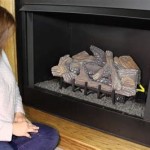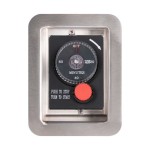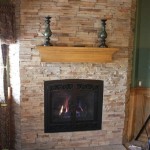How To Clean A Brick Fireplace Surround
A brick fireplace surround adds warmth and character to a home. However, over time, soot, grime, and general dust accumulation can diminish its aesthetic appeal. Regular cleaning is necessary to maintain the surround's appearance and prevent permanent staining. The following guide outlines the steps required to clean a brick fireplace surround effectively, ensuring a safe and thorough process.
Preparation and Safety Measures
Prior to commencing any cleaning activity, it is crucial to prepare the area and prioritize safety. Begin by covering the floor and any nearby furniture with drop cloths or plastic sheeting. This prevents cleaning solutions and dislodged debris from staining or damaging surrounding surfaces. Securing the area significantly reduces the post-cleaning workload.
Dust and soot can irritate the skin and respiratory system. Therefore, wearing appropriate protective gear is essential. This includes gloves to protect the hands from harsh cleaning agents and a dust mask or respirator to prevent the inhalation of airborne particles. Eye protection, such as safety goggles, is also recommended to avoid any accidental splashes of cleaning solution into the eyes.
Ventilation is another critical safety consideration. Open windows and doors to ensure adequate airflow in the room. This helps to dissipate fumes from cleaning products and facilitates the drying process of the brick. If the fireplace is located in a poorly ventilated area, consider using a fan to circulate air.
Before applying any cleaning solution to the entire brick surface, it is advisable to test it on a small, inconspicuous area. This allows for assessment of the solution's effect on the brick and ensures it does not cause discoloration or damage. Choose a spot that is hidden from view, such as the back of the surround or a lower corner. Observe the test area for any adverse reactions before proceeding with the full cleaning process.
Effective Cleaning Methods
Several methods can be employed to clean a brick fireplace surround, ranging from dry brushing to the application of specialized cleaning solutions. The choice of method depends on the severity of the soiling and the type of brick. A combination of methods may be necessary to achieve optimal results.
The initial step in any cleaning process should be dry brushing. Use a stiff-bristled brush, such as a scrub brush or wire brush, to remove loose soot, dust, and debris from the brick surface. Pay particular attention to crevices and areas where soot tends to accumulate. This dry cleaning step significantly reduces the amount of dirt that needs to be addressed with wet cleaning methods.
Once the loose debris has been removed, a mild cleaning solution can be applied. A mixture of warm water and dish soap is often sufficient for lightly soiled brick. Mix a few drops of dish soap into a bucket of warm water and use a sponge or soft-bristled brush to apply the solution to the brick. Gently scrub the surface, focusing on areas with visible dirt or stains. Avoid applying excessive pressure, as this can damage the brick.
For more stubborn stains and soot buildup, a stronger cleaning solution may be required. Trisodium phosphate (TSP) is a powerful cleaning agent that is effective at removing grease, soot, and grime. However, TSP is a harsh chemical and should be used with caution. Always wear gloves and eye protection when working with TSP. Mix the TSP with water according to the manufacturer's instructions and apply the solution to the brick using a sponge or brush. Allow the solution to sit for a few minutes before scrubbing. Rinse thoroughly with clean water.
Another effective option for removing soot and stains is a solution of white vinegar and water. Mix equal parts white vinegar and water in a spray bottle and apply the solution to the brick. Allow it to sit for a few minutes before scrubbing with a brush. Vinegar is a natural cleaning agent that is less harsh than TSP and can be a good alternative for those who prefer a more environmentally friendly approach. Rinse the brick thoroughly with clean water after cleaning with vinegar.
Brick fireplaces can sometimes develop efflorescence, which is a white, powdery substance that appears on the surface. This is caused by salt deposits that migrate to the surface of the brick. To remove efflorescence, use a stiff brush to scrub the affected area. If the efflorescence is stubborn, a solution of muriatic acid can be used. However, muriatic acid is a very strong chemical and must be handled with extreme caution. Always wear gloves, eye protection, and a respirator when working with muriatic acid. Follow the manufacturer's instructions carefully and rinse the brick thoroughly with clean water after cleaning.
After cleaning with any solution, it is essential to rinse the brick thoroughly with clean water. Use a sponge or hose to remove any remaining cleaning residue. Failure to rinse properly can leave a residue that attracts dirt and can damage the brick over time. Ensure that all cleaning solution is completely removed before allowing the brick to dry.
Drying and Sealing
Once the brick has been thoroughly rinsed, allow it to dry completely. This can take several hours or even overnight, depending on the humidity and temperature. To speed up the drying process, use a fan to circulate air around the fireplace surround. Avoid using heat sources, such as a hairdryer or heat gun, as this can damage the brick.
After the brick is completely dry, consider applying a sealant to protect it from future staining and damage. A brick sealant will create a barrier that prevents water and soot from penetrating the brick, making it easier to clean in the future. Choose a sealant that is specifically designed for use on brick and follow the manufacturer's instructions for application. Apply the sealant evenly over the entire surface of the brick, ensuring that all areas are covered.
Some brick sealants are designed to enhance the color of the brick, while others are designed to be invisible. Choose a sealant that meets specific aesthetic preferences. Before applying the sealant to the entire fireplace surround, test it on a small, inconspicuous area to ensure that it provides the desired result.
Maintaining a clean brick fireplace surround involves regular dusting and occasional deep cleaning. Dust the brick regularly with a soft cloth or brush to prevent the buildup of dirt and soot. Spot clean any stains or spills immediately to prevent them from setting. By following these tips, one can keep their brick fireplace surround looking its best for years to come.
In cases of significant staining or damage, it may be necessary to consult with a professional cleaning service. Professionals have the knowledge and equipment to safely and effectively clean brick fireplaces, even in the most challenging situations. They can also provide advice on how to protect the brick from future damage. This option should be considered when other cleaning methods have failed or when one is unsure of how to proceed.
Different types of brick may react differently to various cleaning solutions. For instance, antique or porous brick may be more susceptible to damage from harsh chemicals. Prior research into the specific type of brick is beneficial before selecting a cleaning method. Consulting with a masonry expert can provide valuable insights into the best practices for cleaning and maintaining specific types of brick.
The frequency of cleaning depends on several factors, including the frequency of fireplace use and the surrounding environment. Fireplaces that are used regularly will require more frequent cleaning than those that are used only occasionally. Homes with pets or smokers may also require more frequent cleaning due to the increased buildup of dust and soot. A general guideline is to clean the brick fireplace surround at least once a year, or more often if needed.
Proper disposal of cleaning materials is important for environmental safety. Used cleaning solutions and rags should be disposed of according to local regulations. Avoid pouring cleaning solutions down the drain, as this can contaminate the water supply. Instead, dispose of them at a designated hazardous waste disposal site. Rags that have been used to clean with harsh chemicals should be allowed to dry completely before being disposed of to prevent spontaneous combustion.

How To Clean A Fireplace Diy Basics

How To Clean Fireplace Bricks Simple Practical Beautiful

4 Ways To Clean Soot From Brick Wikihow

How To Clean Brick Fireplaces Mantels Hearths And More My Space

How To Clean A Brick Fireplace With Scrubbing Bubbles 2024 Today S Homeowner

How To Clean Fireplace Bricks 9 Steps With S Wikihow

How To Clean Brick Fireplace 2024 Updated Guide

How To Clean A Fireplace Diy Basics

How To Clean A Brick Fireplace The Family Handyman

4 Ways To Clean Soot From Brick Wikihow
Related Posts








